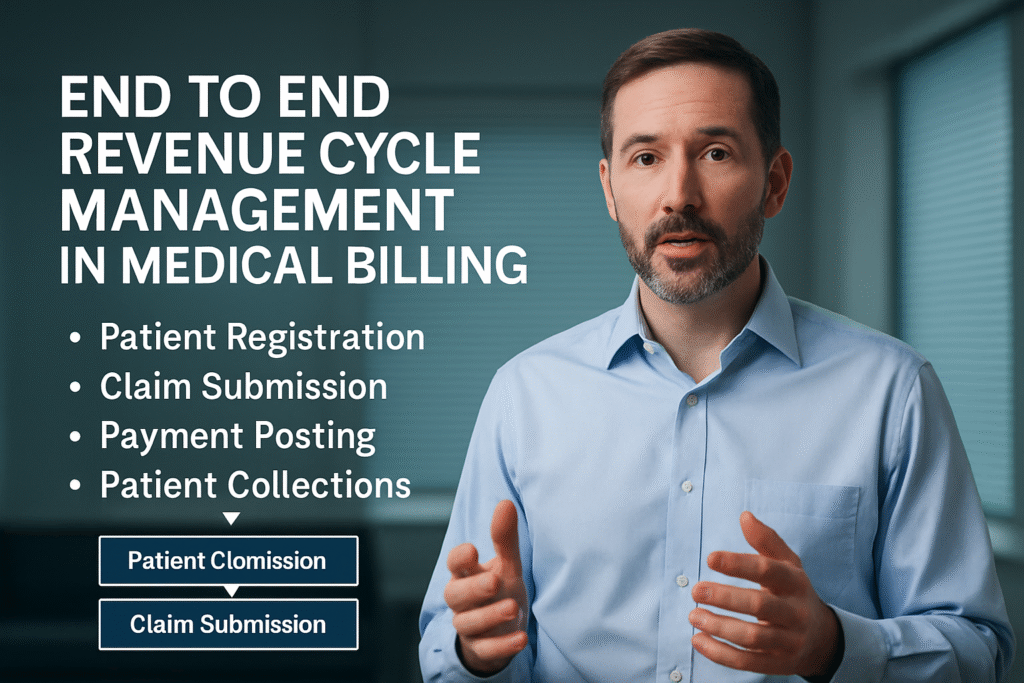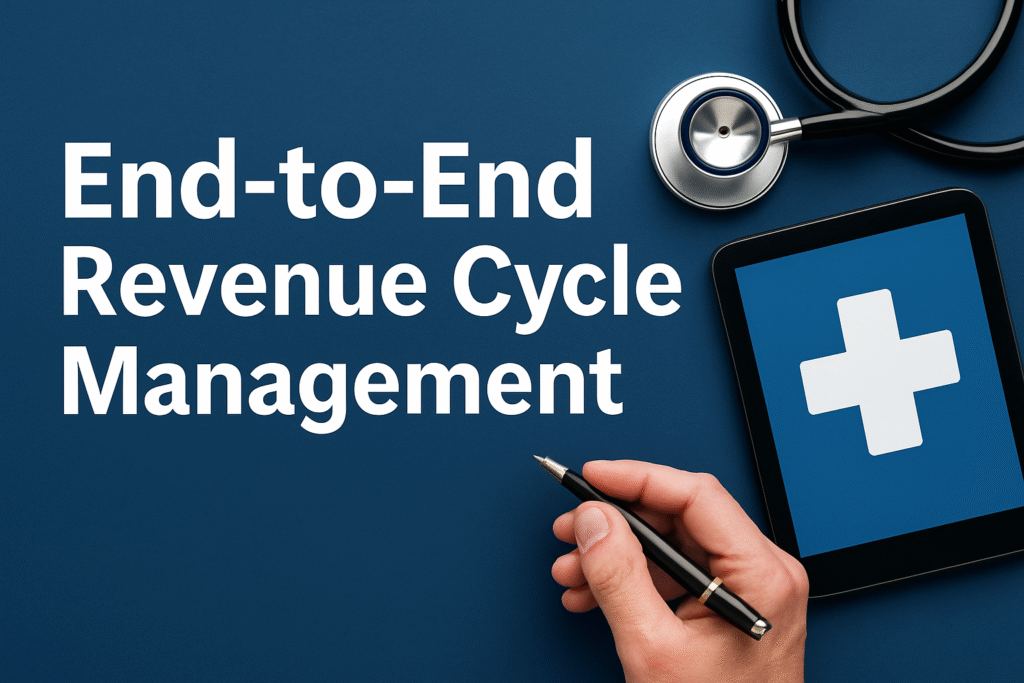In today’s complex healthcare environment, End to End Revenue Cycle Management (RCM) plays a crucial role in the financial health of medical practices and hospitals. From patient registration to final payment collection, an effective RCM strategy ensures timely reimbursement and smooth financial operations. This article explores the comprehensive aspects of End to End Revenue Cycle in medical billing, highlighting its components, benefits, challenges, and best practices.
What is End to End Revenue Cycle Management?
End to End Revenue Cycle refers to the complete process involved in capturing, managing, and collecting revenue from healthcare services. This includes the administrative and clinical functions that contribute to capturing patient service revenue from scheduling and registration to claim submission, payment posting, and patient collections.
The goal of End to End Revenue Cycle is to streamline the entire financial lifecycle of a patient encounter. By integrating all phases of revenue management, healthcare providers can reduce errors, minimize delays, and ensure maximum reimbursement.
Key Components
To understand how End to End Revenue Cycle Management functions, it’s essential to break down its key components. Each stage contributes to the overall efficiency and success of the revenue cycle.
1. Patient Pre-Registration and Insurance Verification
The process begins before the patient even walks into the facility. Pre-registration includes collecting demographic and insurance information, verifying eligibility, and estimating patient responsibility. This step ensures that insurance coverage is active and reduces the chances of claim denial later.
2. Medical Coding and Charge Capture
Once a service is provided, clinical documentation is translated into standardized codes by certified medical coders. Accurate coding ensures proper billing and compliance with regulatory requirements.
3. Claim Submission
In this phase, claims are prepared and submitted to payers. Clean and accurate claims increase the chance of first-pass acceptance, which speeds up the reimbursement process and reduces administrative work.
How End to End Revenue Cycle Management Improves Healthcare Cash Flow
4. Payment Posting and Reconciliation
Payments from insurance companies and patients are posted to the system. It’s crucial to reconcile payments accurately to avoid overpayments, underpayments, or missed entries.
5. Accounts Receivable Management
Accounts receivable (AR) management involves tracking outstanding claims, following up with payers, and resolving denials. Effective AR management reduces days in AR and improves cash flow.
6. Patient Billing and Collections
Finally, patients are billed for any remaining balances. Transparent communication, flexible payment options, and reminders can enhance patient satisfaction and improve collection rates.
Benefits of Implementing Revenue Cycle
Healthcare providers increasingly recognize the need for a holistic approach to financial operations. Implementing End to End Revenue Cycle offers numerous benefits that can transform the operational efficiency of any healthcare organization.
Improved Cash Flow
A seamless RCM process minimizes billing delays and errors, accelerating revenue inflow. By ensuring that every service is correctly billed and reimbursed, practices maintain a steady cash flow.

Enhanced Operational Efficiency
Automation and integration of various RCM components streamline workflows. Staff can focus more on patient care and less on administrative burdens.
Reduced Claim Denials
Proactive verification, accurate coding, and timely submissions significantly reduce the number of claim denials. This results in less rework and higher reimbursement rates.
Better Compliance and Reporting
With healthcare regulations constantly evolving, compliance is a moving target. End to End Revenue Cycle Management includes robust auditing and monitoring systems to ensure adherence to HIPAA, CMS, and payer-specific policies.
Challenges in Revenue Cycle Management
Despite the benefits, End to End Revenue Cycle Management faces various challenges that can hinder its effectiveness if not properly addressed.
Frequent Changes in Payer Policies
Payer rules and coding guidelines frequently change, leading to increased denials and payment delays. Continuous training and updates are required to stay compliant.
High Patient Responsibility
As patients bear more financial responsibility due to high-deductible health plans, collection becomes more complex. Educating patients about their financial obligations is critical.
Integration Issues with Legacy Systems
Many providers still operate on outdated software that cannot support seamless integration. This results in data silos and inefficient communication between departments.
How End to End Revenue Cycle Management Improves Medical Billing Outcomes
Staffing Shortages
Qualified billing and coding professionals are in high demand. A lack of skilled personnel can increase errors and slow down the revenue cycle.
Best Practices for Successful Revenue Cycle Management
To maximize the efficiency and effectiveness of End to End Revenue Cycle, healthcare providers should adopt the following best practices.
Use Advanced Technology
Utilize electronic health records (EHRs), billing software, and automation tools to streamline tasks such as eligibility verification, coding assistance, and claim submission.
Regular Staff Training
Ensure that your billing and coding teams receive regular updates on payer policies, compliance standards, and system updates to reduce errors and rework.
Implement Real-Time Reporting
Real-time dashboards and reporting tools help monitor performance metrics like claim denial rates, AR days, and patient collection rates. These insights support data-driven decision-making.
Strengthen Patient Engagement
Offer user-friendly billing statements, online payment portals, and financial counseling to improve patient experience and increase collections.
Outsource When Needed
If in-house resources are limited, outsourcing End to End Revenue Cycle to a reliable vendor can bring specialized expertise, scalable solutions, and better outcomes.
A Quick Reference Table
| RCM Stage | Purpose |
|---|---|
| Pre-Registration | Collect patient data |
| Insurance Verification | Confirm coverage details |
| Medical Coding | Translate services to codes |
| Claim Submission | Send claims to payers |
| Payment Posting | Record incoming payments |
| Patient Collections | Recover outstanding balances |
Importance of Data Analytics
Incorporating analytics into End to End Revenue Cycle can dramatically enhance performance. By analyzing key indicators such as denial rates, collection percentages, and AR aging, providers can identify trends and adjust strategies accordingly. Predictive analytics can also anticipate cash flow fluctuations and prepare the organization for financial uncertainties.
The Role of Compliance
Compliance is a cornerstone of effective End to End Revenue Cycle. Healthcare providers must ensure that billing practices align with HIPAA regulations, payer-specific rules, and government mandates such as ICD-10 and CPT guidelines. Failure to maintain compliance can result in legal penalties and revenue loss.
How to Choose a Revenue Cycle Management Partner
For organizations looking to outsource, selecting the right partner is essential. Look for vendors with:
- Proven experience in your specialty
- Advanced technology platforms
- Transparent reporting capabilities
- Dedicated support teams
- Strong compliance record
The right RCM partner can serve as an extension of your practice, providing end-to-end services that drive both efficiency and profitability.

Stages/Phases of End-To-End Revenue Cycle Management
The revenue cycle typically includes the front-end (patient registration, eligibility verification), mid-cycle (coding, charge capture, claim submission), and back-end (payment posting, denial management, collections). Each phase plays a critical role in ensuring accurate billing and timely reimbursement.
Typical End-To-End Revenue Cycle Management Services (Front End, Mid-Revenue, and Backend)
Front-end services include scheduling, insurance verification, and patient financial counseling. Mid-revenue services involve medical coding, charge entry, and claims submission, while back-end services handle payment posting, denial resolution, and collections.
Benefits of End-To-End Revenue Cycle Management
Effective end-to-end RCM reduces claim denials, accelerates reimbursements, and improves cash flow for healthcare organizations. It also enhances compliance, minimizes administrative burden, and boosts overall patient satisfaction.
Before You Hire A Revenue Cycle Management Company
Evaluate the company’s experience in your specialty, their technology capabilities, and compliance track record. Ask about reporting transparency, turnaround times, and client success stories to ensure they align with your goals.
Breakdown of End-to-End Revenue Cycle Management Steps
Steps include patient registration, insurance verification, charge capture, coding, claim submission, payment posting, denial management, and collections. Each step must be performed accurately to prevent revenue leakage and maintain compliance.
How End-to-End Revenue Cycle Management Improves Patient and Provider Outcomes
Streamlined billing processes reduce patient confusion over medical bills, improving trust and satisfaction. For providers, it ensures consistent cash flow, reduced administrative workload, and more time to focus on patient care.
Challenges in Implementing End-to-End RCM
Common challenges include integrating RCM software with existing EHR systems, training staff on new workflows, and keeping up with changing payer regulations. Resistance to change and upfront costs can also hinder successful implementation.
Best Practices for Successful End-to-End RCM
Invest in staff training, regularly audit billing processes, and use technology to automate repetitive tasks. Partnering with an experienced RCM provider can further enhance accuracy, efficiency, and compliance.
Conclusion
In a rapidly evolving healthcare landscape, End to End Revenue Cycle is more important than ever. From patient intake to final payment, a comprehensive RCM approach ensures financial sustainability, operational efficiency, and enhanced patient satisfaction. Whether managed in-house or outsourced, aligning every phase of the revenue cycle around best practices and technology is the key to success.
By implementing robust End to End Revenue Cycle, healthcare providers can unlock the full potential of their financial performance and stay competitive in a challenging environment. As regulations tighten and payer expectations grow, adopting a comprehensive and adaptive RCM strategy is not just beneficial, it is essential.
FAQs
What are the key stages of End to End Revenue Cycle Management?
The main stages include patient registration, insurance verification, medical coding, charge capture, claim submission, payment posting, denial management, and patient collections.
How does End to End Revenue Cycle Management reduce claim denials?
By verifying insurance details upfront, using accurate medical coding, and submitting clean claims, the process helps prevent common errors that lead to denials.
Can End to End Revenue Cycle Management be automated?
Yes, many parts of the RCM process can be automated using billing software and integrated EHR systems, such as eligibility checks, coding assistance, and claim tracking.
What’s the difference between traditional billing and End to End Revenue Cycle Management?
Traditional billing often handles tasks in silos, while End to End Revenue Cycle Management takes a holistic, integrated approach to manage the entire billing lifecycle.
How does RCM impact patient satisfaction?
Efficient RCM systems provide clear billing information, timely communication, and easy payment options, which improves the patient financial experience.
Is outsourcing End to End Revenue Cycle Management a good idea?
Outsourcing can be beneficial for practices that lack in-house expertise or resources. It allows professionals to manage the process, reduce errors, and improve collections.
How do you measure the success of End to End Revenue Cycle Management?
Key performance indicators (KPIs) include denial rates, days in accounts receivable (AR), collection rates, first-pass claim acceptance, and patient satisfaction scores.

